Understanding the Odor of Stink Bugs: Why They Smell
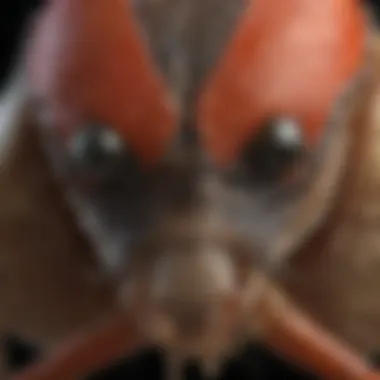

Intro
Stink bugs are often unwelcome guests in homes, and their unique odor can cause significant discomfort. Understanding this smell involves looking into various aspects of the insects themselves. This article will unravel the biological and ecological factors that contribute to the notorious scent emitted by stink bugs, offering insights that go beyond mere annoyance.
By examining the chemical compounds involved, the function of pheromones, and the evolutionary context of this defensive odor, we aim to provide a clear picture of why stink bugs behave as they do when threatened. Additionally, we will discuss practical implications for managing these pests, providing strategies that can be helpful for homeowners and housewives alike.
Understanding the Pest
Identification
Stink bugs belong to the family Pentatomidae. They are generally recognizable by their broad, shield-like shape, along with their distinct coloration. The two most common types in North America are the brown marmorated stink bug and the green stink bug. The brown marmorated stink bug has a mottled brown appearance and can reach up to 17 mm in length, while the green stink bug presents a vibrant green hue and can be slightly larger.
When identifying stink bugs, it is essential to observe their posture. They often remain motionless, which can deceive one into thinking they are not a threat. However, once disturbed, they are quick to release their foul odor, which acts as a warning signal to potential predators.
Life Cycle
The life cycle of stink bugs consists of four stages: egg, nymph, pupa, and adult. Females lay clusters of eggs on the undersides of leaves, with each cluster containing up to 30 eggs. The eggs hatch into nymphs, which resemble miniature versions of adult stink bugs but lack wings. These nymphs progress through several molts before maturing into adults.
Adult stink bugs typically emerge in late spring or early summer. Depending on environmental conditions, they can undergo multiple generations in a single season. Understanding their life cycle aids in pinpointing optimal times for pest control measures, allowing for proactive management of these insects.
Pest Prevention Strategies
Environment Modification
To minimize the presence of stink bugs, environmental factors need addressing. One effective strategy is to seal cracks and crevices around windows and doors. Closing gaps reduces the chance of stink bugs entering living spaces during their search for overwintering sites. Additionally, keeping outdoor lighting to a minimum can reduce their attraction to homes, as they are drawn to lights during nocturnal flights.
Physical Barriers
Implementing physical barriers is another effective method. Installing screens on windows and doors can prevent stink bugs from entering interior spaces. Mesh barriers should be fine enough to keep these insects out while allowing air flow.
Control Methods
Chemical Control
In instances where prevention fails, chemical control can be considered. Insecticides specifically formulated for stink bugs are available. Products containing pyrethroids or neonicotinoids can target these pests effectively. Applying them during the nymph stage may yield the best results, as adults tend to be more resilient.
Biological Control
Exploring biological control offers a more sustainable approach. Natural predators such as certain wasps can help manage stink bug populations. Introducing these beneficial insects into the ecosystem can maintain a balance without the need for harsh chemicals.
"Understanding the biology and ecology of stink bugs is key for effective management."
The Biology of Stink Bugs
Understanding the biology of stink bugs is essential for comprehending their odor and behaviors. These insects, part of the Pentatomidae family, have developed unique adaptations that enhance their survival. Focusing on their anatomy and habitat provides insights into why they exhibit such distinctive characteristics, particularly the defensive odor that they are widely known for.
Anatomy Overview
Stink bugs possess a simple yet effective anatomical structure. Their body is generally shield-shaped, which aids in camouflage. The most notable aspect of their anatomy is the specialized glands located beneath the thorax. These glands are responsible for producing the foul-smelling chemicals that are released in defense. The combination of these chemicals varies across species, leading to a range of smells that can be identified by predators.
Stink bugs typically measure between 1/2 to 1 inch long, with a hard shell protecting their body. They have six legs and two pairs of wings, which help them in flight and in navigating their environment. The overall structural design of stink bugs allows them to escape predators swiftly while maintaining a defense mechanism effective enough to deter threats.
Habitat and Species Diversity
Stink bugs are adaptable insects found in diverse habitats. They thrive in various environments, including agricultural fields, gardens, and even urban areas. This versatility is one reason why they can be found in homes and gardens across a wide geographical range. Their habitat selection often reflects their feeding preferences, as many species feed on plants, which are readily available in numerous settings.
There are over 200 species of stink bugs in North America alone. Each species displays unique preferences for food plants, contributing to their varied odors as well. For example, the brown marmorated stink bug is known for invading homes during the cooler months, while many native species inhabit gardens and woods. Understanding stink bug diversity is crucial for effective management and control, especially for homeowners attempting to mitigate infestations.
"The adaptability of stink bugs to different environments makes them a challenge for pest control."
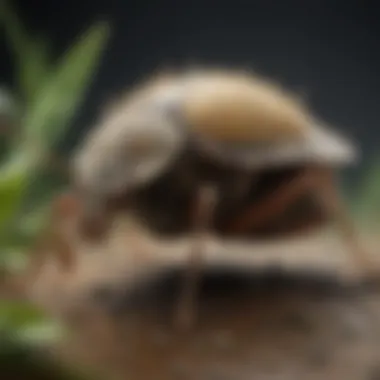
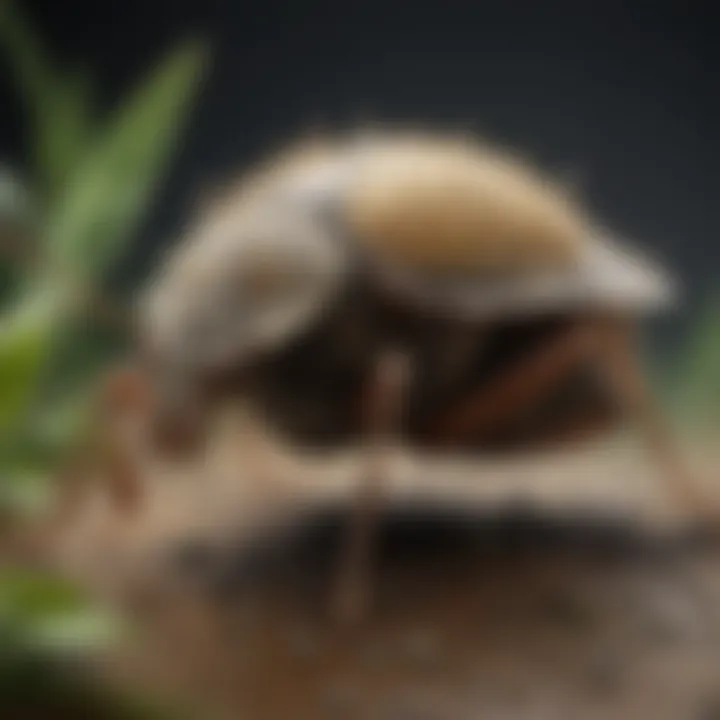
In summary, the biology of stink bugs encompasses vital aspects that explain their unique odor and behavior. Their anatomy equips them for both offense and defense, while their diverse habitats and species enhance their presence in various environments. Through studying these elements, one can more effectively manage stink bug populations and mitigate the unpleasant experiences associated with their odor.
Chemical Composition of Stink Bug Odor
The chemical composition of stink bug odor is a central focus in understanding why these insects emit such strong scents. These scents serve multiple functions, primarily as a defense mechanism against predators. A deeper appreciation of the compounds that create their unique odor can help homeowners grasp the potential impacts of stink bug infestations on daily life and property. Ultimately, understanding how this chemical composition works can guide preventive measures and management strategies.
Key Chemical Compounds
Stink bugs are equipped with specialized glands that release various chemical compounds. Among these, the primary compounds include:
- Alkaloids: These nitrogen-containing compounds have been observed to contribute to the character of stink bug smells.
- Aldehydes: Known for their strong, pungent odors, aldehydes can be especially dominant in the stink bug's scent profile.
- Terpenes: These are produced by many plants and insects, playing a role in the distinctive nature of stink bug odors.
The complexity of these chemical compounds defines the intensity and type of odor emitted. Studies suggest that the blend of these substances not only deters predators but may also attract mates or communicate with other stink bugs. This multi-functional aspect of stink bug odor illustrates its evolutionary importance.
The Role of Volatile Organic Compounds
Volatile organic compounds (VOCs) represent another significant group within the chemical makeup of stink bug odor. VOCs are characterized by their ability to evaporate easily and carry scents through the air. Their role in stink bugs extends beyond mere odor production. Here are the key points about the significance of VOCs:
- Attraction and Repulsion: Some VOCs can attract other stink bugs for mating, while others repel potential threats. This dual role enhances the survival of the species.
- Chemical Communication: These compounds facilitate communication among stink bugs. They may signal alarm or alert other bugs to dangers in the environment.
- Impact on Humans: The VOCs that stink bugs release can have consequences for humans as well. Understanding these can assist in better pest control and management practices.
"The scent of a stink bug is a complex cocktail of odoriferous compounds, providing insights into their behavior and ecological role."
In summary, the chemical composition of stink bug odor, highlighted by key compounds and VOCs, plays a crucial role in the survival strategy of these insects. For homeowners, recognizing these nuances can lead to more effective pest management and a better understanding of how to handle stink bug encounters.
Stink Bug Defense Mechanisms
Understanding the defense mechanisms of stink bugs is crucial. These insects rely heavily on both chemical and behavioral adaptations to avoid predation. Their very distinctive odor plays a significant role in these defense strategies. When threatened, stink bugs release chemicals that can deter or confuse predators. This article will delve into two main categories of defense mechanisms that stink bugs exhibit: chemical defenses against predators and their behavioral responses to threats.
Chemical Defenses Against Predators
Stink bugs possess a unique arsenal of chemicals when attacked. These chemicals are not by-products but rather integral components of their survival strategy. The scent produced by stink bugs comes from a combination of compounds secreted from glands located in various parts of their bodies. Notably, these include aldehydes and other volatile organic compounds.
The odor can vary among stink bug species. Halyomorpha halys, also known as the brown marmorated stink bug, is known for its particularly foul smell when disturbed. This unpleasant odor serves several functions. First, it acts as a warning signal, alerting potential predators that the stink bug might be unpalatable or toxic.
Additionally, many predators learn to associate the scent with an unpleasant experience, thus within a short period, developing aversive behaviors toward these pests. Moreover, the release of chemicals can sometimes attract other predators to the area, effectively calling in reinforcements to deal with a common threat.
"The chemical defenses of stink bugs exemplify an evolutionary response to predation, emphasizing the relationship between chemical communication and survival."
Behavioral Responses to Threats
In addition to the chemical deterrents, stink bugs also exhibit specific behaviors to avoid predation. When they sense a threat, stink bugs can adopt various stances, such as remaining still or moving to obscure locations. This behavior reduces the chances of being detected by predators.
Stink bugs also engage in defensive posturing. For example, they may inflate their bodies to appear larger or more intimidating to potential threats. Furthermore, during moments of stress, stink bugs have demonstrated the ability to drop to the ground or hide under leaves or debris, making them less visible.
In instances where all else fails, stink bugs may resort to flight. Although their wings do not allow for prolonged flight, they can hop away quickly from threats. This combination of chemical and behavioral defenses is vital. It allows stink bugs to navigate their environment effectively while minimizing risks from predators.
Through understanding these defensive strategies, homeowners can gain insight into the importance of stink bugs in their ecosystem. While often viewed as pests, stink bugs fulfill a role in maintaining the balance of local environments.
Ecological Significance of Stink Bug Odor
Understanding the ecological significance of stink bug odor is essential for comprehending their role in the environment. The smell emitted by stink bugs is not merely a nuisance; it serves critical functions that impact both their ecosystem and human society.
One of the primary aspects of stink bug odor is its role in pest control. Stink bugs, especially species like the brown marmorated stink bug, can act as natural enemies to various pests. Their excreted odor can repel other insects that might invade crops, thus acting as a protective measure for plants. When these insects release their scent, it can signal danger, leading to a reduction in pest populations. This self-defense strategy encourages a balanced ecosystem and potentially limits the need for synthetic pesticides in agricultural settings.
Role in Pest Control
The mechanisms by which stink bug odor aids in pest control are multifaceted. For one, the odor serves as a warning system. When a stink bug feels threatened, the compounds released can deter predators as well. As an example, certain species produce a specific blend of chemicals that can aggravate or confuse predators, making them less likely to consume stink bugs.
In some cases, the scent can also disrupt pheromone-based communication among pests, rendering them less effective at finding mates or food sources. This disruption can lead to decreased reproduction rates amongst pest populations, further enhancing agricultural protection.
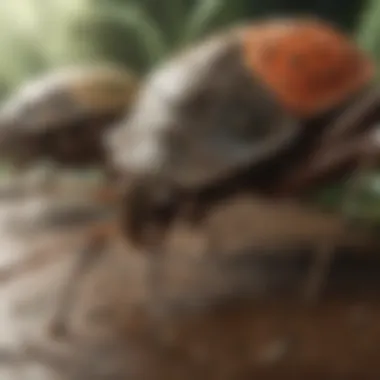
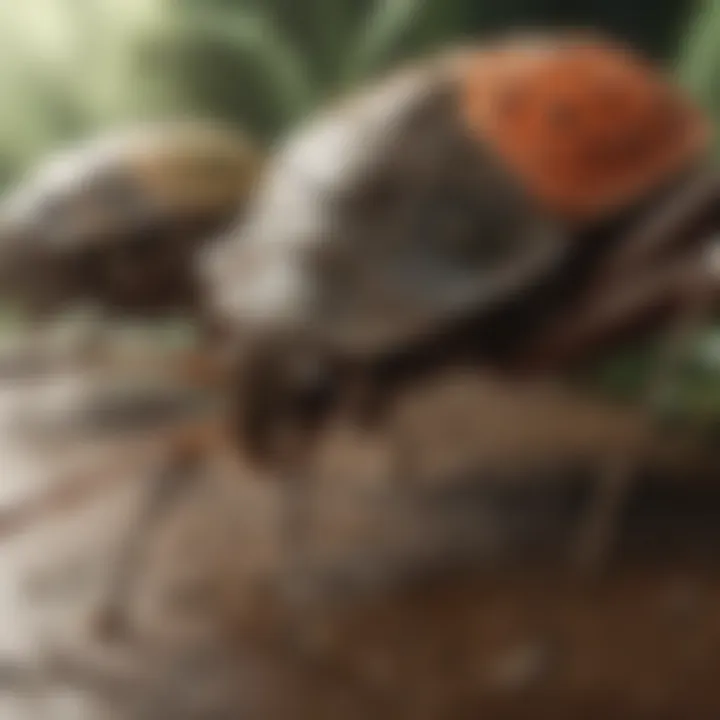
Impact on Ecosystem Dynamics
The odor of stink bugs also plays a profound role in ecosystem dynamics. Stink bugs are considered an integral part of the food web. Their interactions with various species help shape the demographic and health aspects of an ecosystem. When stink bugs release their characteristic odor, it not only affects pests but also influences other insect species, altering predator-prey relationships within an environment.
Moreover, the presence of stink bugs can indicate ecological health. Their population dynamics are often reflective of environmental conditions, making them useful bioindicators. If their numbers decline, it could signal underlying ecological issues, prompting further investigation into ecosystem stability.
"Stink bug odors contribute to the balance of nature, affecting both their survival and the well-being of other species within their habitat."
The Interaction of Stink Bugs with Humans
Stink bugs play a notable role in human environments, particularly as they tend to invade homes during colder months. Understanding this interaction sheds light on both the ecological functions of these insects and the challenges they create for homeowners. Their presence raises questions about pest management, hygiene, and the overall dynamics between wildlife and human habitats.
Incidence of Infestation in Homes
Stink bugs, particularly the brown marmorated stink bug, have become a common nuisance in many households. They often seek warmth and shelter when temperatures drop, making homes an attractive destination. Reports indicate that infestations can reach significant levels, particularly in suburban and rural areas where agricultural practices are prominent.
- Signs of an Infestation: Common signs include an increase in sightings, particularly near windows and doors. Homeowners may also detect the characteristic odor even before seeing the bugs.
- Time of Year: Infestations are most prevalent in late summer and fall. Stink bugs can enter through tiny openings, and once inside, they tend to stay dormant during winter months, only to emerge in spring.
Managing these infestations requires awareness of their habits. Homeowners need to check for entry points and take preventive measures before the cold weather sets in.
Common Human Reactions and Misconceptions
The presence of stink bugs often evokes strong reactions, ranging from irritation to panic among homeowners. Many misconceptions persist regarding these insects.
- Odor Panic: The most common reaction is alarm upon encountering the bugs. People often fear that the odor will linger permanently. However, the smell dissipates quickly if the stink bug is removed promptly.
- Harm to People and Pets: Many believe stink bugs are harmful to humans or pets. This is largely untrue. While their odor can be unpleasant, they do not bite or transmit disease.
- Effectiveness of DIY Solutions: Homeowners sometimes resort to home remedies for removal, believing they can effectively manage infestations without professional help. However, these methods often fall short and can even make the situation worse.
"Stink bugs do not pose health risks to humans, but their odor can be off-putting and challenging to manage during infestations."
Increasing awareness and understanding of stink bugs can lead to smarter management practices and a decrease in the stress associated with their presence. Being informed helps homeowners deal with infestations calmly and effectively.
Management and Control Strategies
Effective management and control strategies are crucial for dealing with stink bugs. This topic holds significant relevance in the context of both pest control and homeowners’ peace of mind. Understanding these strategies can help mitigate the unpleasant odor associated with stink bugs, reduce their presence, and prevent infestations from occurring. For homeowners, having a clear plan is essential. It minimizes disruptions and potential damage to property. Moreover, it can save time and resources in the long run.
Preventive Measures for Homeowners
Homeowners can take several preventive measures to keep stink bugs at bay. Firstly, sealing entry points is vital. Inspect your home for gaps around doors, windows, and other potential entryways. Use weather stripping and caulk to close these openings. This simple action can significantly reduce the chances of stink bugs entering your home.
Secondly, maintaining clean surroundings is essential. Stink bugs are attracted to food sources and clutter. Regularly check your home for food debris, especially in the kitchen. Keep pantry items sealed and stored away from common areas. Additionally, removing any outdoor debris, such as piles of leaves or refuse, can help limit the environment that attracts them.
Using screens on windows and vents also offers an effective defense. Ensure that any screens are intact and free of holes. Considering the outdoor environment, keep garden and landscaping clean. Regularly inspect plants for signs of stink bugs and remove them promptly.
Effective Removal Techniques
If stink bugs manage to enter your home, effective removal techniques are necessary. One common technique is vacuuming. Use a vacuum cleaner with a bag to collect the bugs. This method is straightforward but requires caution. Remember not to crush the bugs, as they can release their odor when threatened. If you do not wish to use a vacuum, consider using a bait trap, which can attract and capture stink bugs.
Another technique involves the use of insecticidal soap. Spraying this soap on stink bugs can effectively eliminate them. It is essential to follow the instructions on the product label and apply it in well-ventilated areas. When treating the outdoors, targeting sunny areas can potentially reduce their population.
For those who prefer natural methods, consider creating a homemade repellant. A mixture of dish soap and water can serve as an effective solution. Spray this mixture on the bugs you encounter. Be persistent and thorough for the best results.
Preventative strategies combined with effective removal techniques create a powerful approach for dealing with stink bugs.
Research and Innovations in Stink Bug Studies
Research into stink bugs has become increasingly important in recent years due to their growing prevalence as pests in various regions. Understanding their behavior, particularly concerning their odor, offers significant insights not only for pest control strategies but also for broader ecological impacts. Researchers aim to unravel the complexities of the chemical compounds released by stink bugs, which serve both as a defense mechanism and a means of communication. The implications of this research extend beyond simple pest management and delve into the intricate interactions between species in their ecosystems.
Recent Findings on Stink Bug Behavior
Current studies have revealed fascinating aspects of how stink bugs navigate their environments and interact with threats. One significant finding highlights the role of pheromones in varying situations. For instance, researchers have discovered that stink bugs release specific chemicals in response to different predators or stressors. This chemical communication operates on a level that indicates their perception of danger and can trigger defensive behaviors among other stink bugs nearby.
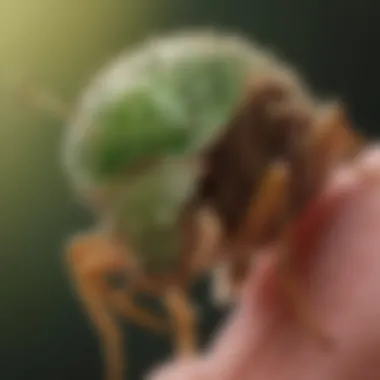
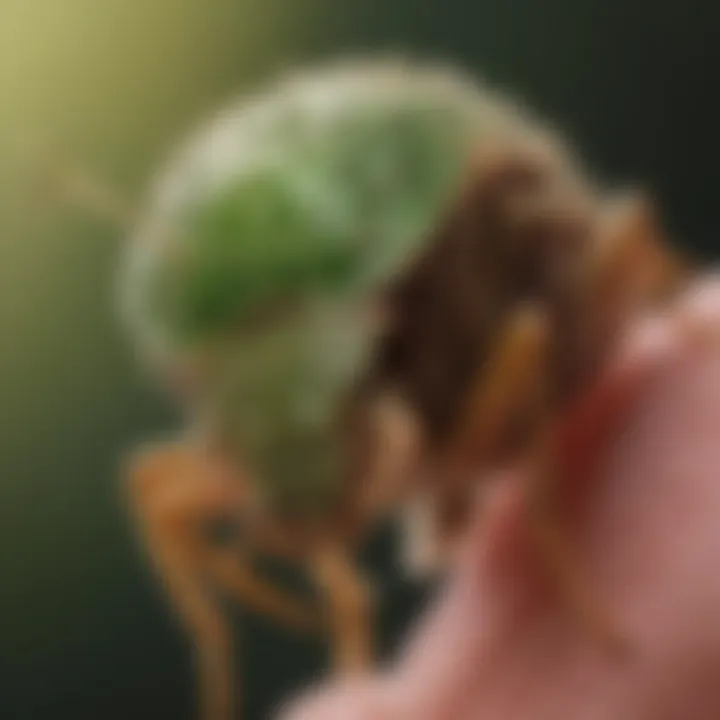
Recent lab experiments note that exposure to certain predators led to changes in chemical release patterns, suggesting adaptability in their defensive strategies.
Moreover, researchers have emphasized the influence of environmental factors on stink bug behavior. For example, studies suggest that changes in weather patterns and habitat alterations affect not only the populations of stink bugs but also their scent production. Understanding these responses is critical for formulating more effective pest control measures that consider ecological balance.
Future Directions in Stink Bug Research
As research in stink bug studies continues to evolve, several future directions seem promising. One area of focus is the development of non-toxic control measures inspired by the chemical makeup of stink bug defense mechanisms. Scientists aim to replicate these natural chemicals for use in both repelling pests and preserving beneficial insects.
Another exciting aspect is the integration of technological advancements in studying stink bug behavior. The use of remote sensing and digital analysis can enhance the tracking of populations and their interactions with the environment. Such technology can provide real-time data, potentially leading to rapid responses to infestations.
Finally, increasing awareness regarding the impact of stink bugs on crops and gardens presents a significant opportunity for research. Future studies could evaluate the economic implications of infestations and find innovative ways to mitigate their effects on agriculture. The aim is to combine knowledge from various disciplines, including ecology, chemistry, and technology, to deepen the understanding of stink bugs and devise holistic management solutions.
Continuing this multi-faceted research is vital as stink bugs adapt to changing agricultural practices and climate conditions. Through ongoing innovations and studies, we can develop better tools to monitor, manage, and potentially use stink bugs in ways that benefit both homeowners and the ecosystem.
Consumer Awareness and Education
Consumer awareness and education about stink bugs are essential for effective management and control of these insects. Many homeowners are unfamiliar with the behaviors and characteristics of stink bugs, which can lead to misinformed decisions when confronted with an infestation. By educating themselves about these insects, homeowners can take proactive steps to prevent infestations and mitigate their impact.
Understanding stink bug behavior is the first step. Stink bugs react defensively when threatened, often releasing their characteristic odor as a part of their survival strategy. Recognizing when and why they produce this smell can inform effective responses. Homeowners can better assess potential threats in their environment and take specific actions to deter these pests, such as sealing entry points in their homes or avoiding the temptation to crush them if they are encountered indoors.
Moreover, a significant benefit of awareness is the ability to distinguish stink bugs from other pests. Stink bugs, especially the Brown Marmorated Stink Bug, are often mistaken for other insects, leading to confusion in pest control measures. Clear identification can prevent unnecessary stress and ineffective treatments.
"Educated homeowners are empowered homeowners. Understanding the science behind stink bugs leads to smarter pest management strategies."
In addition, educational resources can also aid homeowners in grasping the ecological role of stink bugs. While they can be a nuisance, they also play a part in their ecosystems. Learning about their behaviors can lead to more beneficial coexistence and reduce the impulsive use of chemical treatments, which may harm beneficial insects. The more informed a homeowner is, the more sustainable and effective their pest control methods will be.
Finally, being educated about stink bugs empowers individuals to seek appropriate resources when dealing with infestations. It encourages proactive measures rather than reactive responses, ensuring a comprehensive understanding of the related issues, thus facilitating a more comprehensive management approach.
Understanding Stink Bug Behavior for Better Management
Recognizing the behavior patterns of stink bugs is important for homeowners. These insects are typically more active in late summer and fall as they search for warm places to overwinter. A clear understanding of their seasonal behaviors can help in preparing homes to resist invasions during these peak times.
Monitoring signs of stink bugs is key. Homeowners should look out for visual signs like spotting the insects themselves or their droppings. Early detection can lead to timely interventions, which are much easier to manage than a large population.
Another critical aspect is the response to the smell. The odor serves as a defense mechanism, triggering additional stink bug behaviors. If homeowners know that the odor often indicates distress, they can avoid further provocations that would lead to more scent being released. Instead of squashing them, methods like gently capturing and releasing them outside are recommended. This not only reduces the odor issue but also helps in managing stink bug populations without resorting to chemicals.
Ultimately, a proactive understanding combined with practical behavioral insights allows homeowners to reduce stink bug-related problems significantly.
Resources for Homeowners and Pest Control Professionals
Homeowners and pest control professionals alike can benefit immensely from available resources focused on stink bugs. An understanding of effective pest management strategies can be found in various established platforms.
- Online Guides: Websites like Wikipedia and Britannica provide comprehensive information on stink bugs, including their biology and behavior.
- Community Forums: Engaging with platforms such as Reddit can offer valuable peer insights. Homeowners often share personal stories and successful tactics that worked in their households.
- Local Extension Services: Many universities have extension services that provide localized guidelines on pest management, including stink bug control. Homeowners can connect with these services for tailored advice.
- Professional Pest Control: For more severe infestations, consulting professional pest control services can be beneficial. These experts often use integrated pest management approaches, which can include identifying the source of the problem and recommending safe treatment methods.
By utilizing these resources, homeowners can access a wealth of information to manage stink bugs effectively. Education, combined with practical resources, ensures a better response against these challenging pests.
Wrap Up: The Complex Life of Stink Bugs
Understanding the intricacies of stink bugs is crucial in comprehending their unique odor and its implications. Stink bugs serve multiple ecological roles, contributing to both pest control and food chains. This wrap up synthesizes insights gained throughout the article, drawing connections between biology, chemical composition, defense strategies, and human interactions with these insects.
Recap of Key Insights
The examination has provided several key insights about stink bug odors:
- Biological Mechanisms: Stink bugs possess specialized glands that produce chemicals which generate their characteristic smell. These compounds serve both as a defense mechanism and a means of communication.
- Chemical Composition: The odor comprises various volatile organic compounds. Understanding these chemicals helps in formulating effective pest management strategies.
- Ecological Significance: Stink bugs have a dual role in ecosystems. They act as pest predators while also being prey for other species. This balance affects their odor production and its efficacy.
- Human Interaction: Homes often become breeding grounds for stink bugs, leading to unpleasant encounters. Knowledge of their behavior aids in mitigating infestations.
"Stink bugs are not just pests; they play a vital role in our environments, influencing ecological dynamics significantly."
Final Thoughts on Managing Stink Bug Infestations
Managing stink bug infestations requires a nuanced understanding of their behavior and ecology. Homeowners can benefit from several approaches:
- Preventive Strategies: Seal potential entry points in homes, like cracks and openings, to deter infestations. This proactive method reduces encounters considerably.
- Identification of Species: Knowing which species are common in your region helps target control measures effectively.
- Chemical Treatments: Use targeted insecticides designed for stink bugs. Applying these treatments before the peak season may provide better control.
- Natural Predators: Encourage attractants for natural predators like birds, which can help in controlling stink bug populations.
By implementing these strategies and maintaining awareness of stink bugs’ behaviors and habits, homeowners can manage infestations effectively. This understanding not only leads to a more pleasant living environment but also contributes to the broader ecological balance. Stink bugs, though often viewed as nuisances, are integral components of our ecosystem, necessitating responsible management and education.







